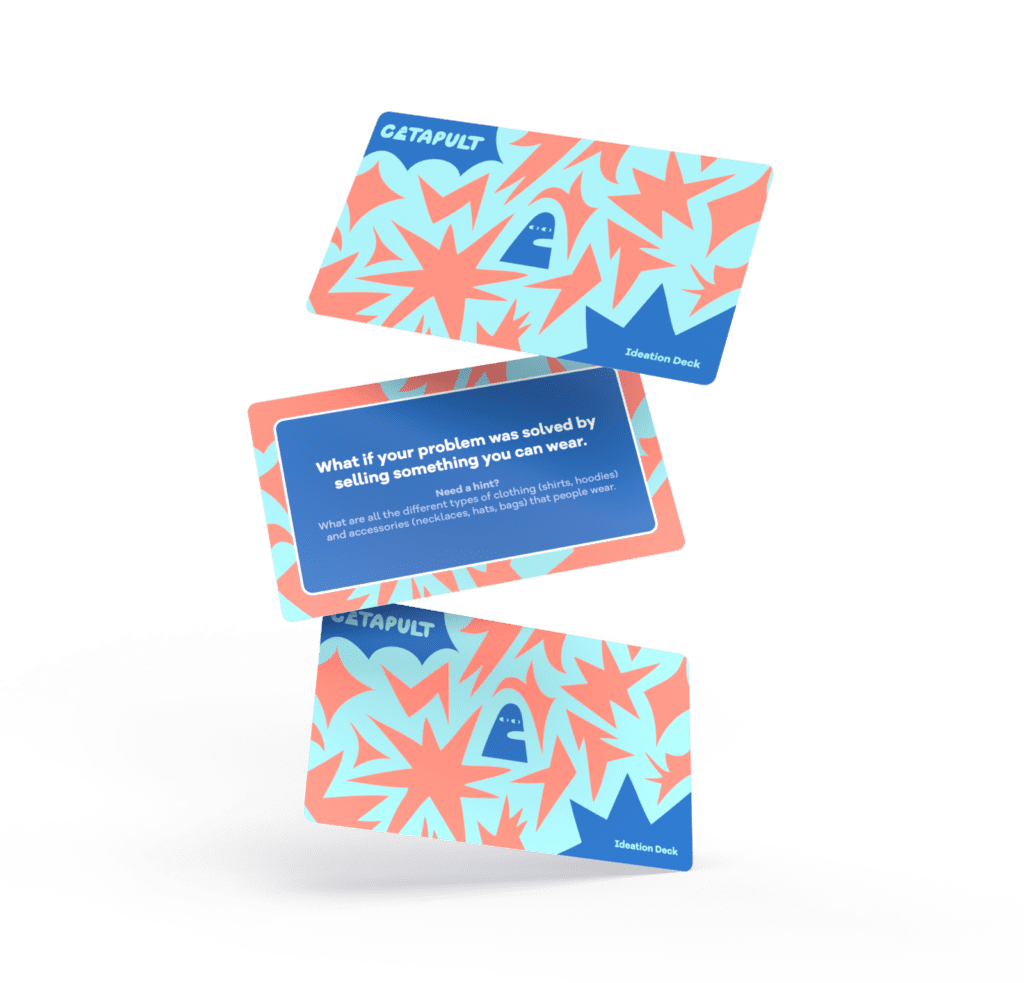
Bust Out of Brainstorming: Ideation for Creative Thinking
by Jarred Turner, Future Anything (Program Manager)
In today’s blog, Jarred Turner from Future Anything explores how ideation (idea creation) can be used as an exercise to spark creativity and confidence in the classroom.
Before brainstorming, there was a situation I found myself in a few times as a teacher.
It went something like this…
I had my learning goals ready, my students focused, and I was rearing to go at the whiteboard.
It was time to brainstorm.
I imagined that my students would fire away with suggestions. The board would be full of great ideas. I would be writing furiously to capture it all.
In fact, me lesson depended on this outcome.
But when I kicked things off, none of this happened.
Instead, my class was silent.
There were blank faces.
No one seemed willing to suggest a sneeze, let alone an idea.
I pulled out all the tools I had in my toolkit:
- I reframed the question.
- I gave hints
- I showed a video to spark some thinking.
- I got the class started with a few suggestions.
But, each time I stopped speaking, the silence was deafening.
If you’ve been in a scenario like this, you’re not alone and this isn’t your fault.
The reality is, we coach young people to be incredible ‘critical thinkers’; converging to offer the most correct choice.
When it comes to creative thinking, and the divergent ‘possibility mindset’, theres-no-wrong-answer approach required to be creative thinkers, our young people sometimes lack the risk appetite required to put forward a suggestion in fear it could be ‘wrong’. They play it safe, waiting for certainty before offering suggestions.
In the release of our most recent Future Anything Capability Framework, Creative Thinking is defined as:
…the ability to generate, refine, and apply novel ideas in meaningful ways.
To be a creative thinker, young people need to be:
- Imaginative: Generating bold, original, or unusual ideas.
- Optimistic: Iterating on ideas and staying open to solutions—even in the face of failure.
- Experimental: Testing and refining ideas through trial, error, and feedback.
Creative thinking, as a capability, is a muscle that can be built and developed. You just need to a) set the culture for creative thinking to happen and b) build the capability with fast, frequent and fun practice.
Setting the culture for creative thinking to happen.
Creative thinking doesn’t happen by accident.
To set the foundations for this creative thinking in your classroom, it’s important to establish the conditions for creativity. At Future Anything, our “conditions of ideation”—inspired by research and best practice—are introduced every time we dig into creative thinking – setting the ground rules and the culture that enable young people to be imaginative, optimistic and experimental.
Go Big
The first Rule of Play is to shoot for as many ideas as possible.In the creative process of ideation, quantity breeds quality. The reasoning is simple: when you have more ideas to choose from, you are more likely to develop an excellent idea.
Creativity is a skill that people develop, so practice and persistence are essential in the development of that skill. By shooting for as many ideas as possible, and moving quickly between the generation of ideas, students gain lots of consistent practice at being creative and can develop confidence with the process faster.

Go Wild
Crazy and out-there ideas are encouraged during ideation, because they can be the inspiration for excellent solutions. As research compiled by the OECD indicates, classroom environments where students feel free to take risks and express unusual ideas can foster more creative thinking. In creative learning there is no right answer, so why limit your students to reasonable and feasible ideas right at the beginning? Wild ideas often have elements of excellence in them that can be distilled into a functional and exciting solution later. So, encourage your students to go wild in their thinking and break free of all limitations.
Additionally, esteemed creativity gurus Tom Kelley and David Kelley – who have helped hundreds of major corporations use creativity to unlock innovation, recommend that judgement is suspended during the ideation process. This means that every idea is written down – whether it’s good or bad. This frees individuals and groups from self-censorship; making it far easier to ‘go big’ and generate 100 ideas rather than 10.
Go Together
Students should build upon the ideas of others. Rather than rejecting the ideas of their peers or providing reasons why they won’t work, expert practitioners and pedagogy advocates argue that positive language to encourage and extend the thinking of others supports creative thinking. Simple language markers like ‘yes, and…’ can help students to build on each other’s ideas.
With reminders to keep a collaborative spirit, an openness to wild ideas, and a focus on quantity over quality; your students will be well versed in the creative conditions for ideation.
Ideation Strategies
Once you’ve established the culture for creative thinking, you need a structure for the experience.
We recommend using three to five strategies back-to-back in quick succession. By manipulating the conditions of the strategy (the ‘how’) and the constraints (the ‘what’) you can unlock different ideas.
In each of the strategies below, you’ll see how these two things can be changed to make for interesting and variable approaches to ideation.You should choose a mixture of strategies – some that are collaborative, leveraging team discussion, some that are individual, prompting quiet and focused thinking, and some that involve movement and a change of environment to unlock different ideas.
It must be said, the fear of getting started, being judged, or of not being a ‘creative person’ are common blockers to creative thought.
By using a range of ideation strategies in quick succession (and often!), you can cut through these fears by plunging students straight into the creative experience with a set of clear steps to guide them. The stacking of strategies means that whilst some students will flourish under some conditions, and constraints, others will thrive under the next; unlocking creative thinking in different ways for different young people.
Strategy 1: Post-It Note Ideation (5 minutes)
In this strategy, students go big, go wild, and go together by ideating in response to a prompt you provide.
When we say ‘prompt’, we mean a provocation that students need to solve. The key is that the prompt needs to be open ended enough that it could be solved in 100+ different and unique ways.
Example prompts:
- Ideate as many ways you can think of to convince or compel your Principal to agree to hosting Music Festival at your school.
- Ideate as many ways this plastic water bottle could be reused, recycled or repurposed.
- Ideate as many ways you can think of to make public transport more attractive than driving a car.
To really leverage the cultural condition of ‘go together’, students should work in a groups of 4-6 standing around a table.
Each person in the group should have a stack of post-it notes and a pen, and they should say an idea out loud as they write it on one of their post it notes, placing it in the middle of the group’s table; amassing a massive stack as a team. Hearing the ideas of their peers can spark other ideas within a group, helping students to build on each other’s thinking.
A key constraint of this activity is that only one idea should be written on each post-it note. This helps students to keep their thinking about each idea brief. It’s hard to write a lot on a single post-it note; so this stops a group from getting caught up in one idea.
The ideal timer for this activity is 3 minutes. Get students standing, put a timer on the board, and consider cranking the tunes.



Strategy 2: Quiet Ideation (5-10 minutes)
Not every young person likes ideating collaboratively and out loud. To complement the previous style of post-it note ideation, quiet ideation works as a perfect follow up strategy. Your extroverted students will really get into the previous strategy, gaining energy from their interactions with others. But the creative benefit of quiet ideation, with its focus on individual thought, will apply to all students.
Productivity research and social psychology have identified a number of factors that can limit the effectiveness of group brainstorming situations, and as a result, studies indicate that people can generate a higher number of original ideas when given the opportunity to think alone.
The constraints of quiet ideation create this opportunity. Students will ideate individually, and without talking. They could ideate on post-it notes again, or in their notebooks. Establish your conditions to support this – you might encourage students to sit on the floor of the classroom, or you might give your class the opportunity to find a quiet space for individual thought outside (indeed, research suggests that spending time in nature can boost creativity).
Similarly, set a 3-5 minute timer (or 7-10 if students are wandering solo outside) and silence the tunes to honour the quiet space required to think deeply.

Future Anything’s Catapult Cards contain a huge range of excellent prompts to support ideation.
Strategy 3: Pacman (3 minutes)
After harnessing the power of individual thought, it’s time to add another layer of variability. Pacman is a strategy which utilises the collective wisdom of individuals a class by getting students to interact with many of their peers in a short amount of time.
Like Pacman, students will walk around and ‘bump’ into as many of their peers as possible in a 3 minute time period. The key condition here is keeping the conversations quick. Student A will provide their prompt, Student B will offer a suggestion. Student B (without commenting on the idea) will write it down. Then they swap. Each rapid-fire exchange should only be 15-20 seconds.
One element to keep ideas moving is to keep students moving. Even as they pair up, they must keep walking side-by-side. This can help avoid stagnant groups getting ‘stuck’ in a spot chatting.
At the conclusion of the activity, students will have been challenged to help others on a range of scenarios, and they will also have additional ideas themselves.
Strategy 4: Generative AI (10 minutes)
Technology can play a role in ideation, too. Generative AI tools like Perplexity.AI, ChatGPT, and Microsoft Copilot are remarkably good at suggesting ideas. To set students up for success in using Generative AI for ideation, your core condition is the prompt that students put into the AI. Keep it simple first. Here’s an example:

Generative AI is a wonderful tool to help students take their thinking in multiple directions. This can be achieved through follow up prompts. Some examples include…
- Tell the AI the ideas which were your favourite. Ask it to generate more like this.
- Ask the AI… “This is on the right track, can you give me 5 more ideas that a teenager could create with minimal cost?”, or even, “Can you give me 5 more ideas that I could launch in my school?”
- Redirect the AI… “I need my idea to be original. Can you rank the ideas from most to least original, and offer me ten more suggestions that are wild, unique and futuristic.”
After the AI generates ideas for your learners, add a constraint that encourages students’ own creativity. This could be to extend upon the best ideas the AI created. Or, students can combine the ideas it creates, with those they already have to form a few super ideas.
As students experiment with the AI, you may find it reasonable to allow more time for this ideation strategy than the others.
Strategy 5: Harvest (5 minutes)
A handy finishing touch for an ideation session, Harvest gets students up and moving again to access the thinking of others.
This is an opportunity for a bit of light-hearted thievery. In a Harvest, the first condition is for students to lay out all of their ideas on their table so that anyone can see them. Then, they will roam around the classroom with something blank to write on.
Students will write down ideas to steal, or borrow and adapt, from other groups. The key constraint is using other people’s thinking for inspiration.
After gaining inspiration from others, students will enjoy pooling together what they have found to enhance their list of ideas.
Capabilities are developed with fast, frequent and fun practice.
To get started, just choose your strategies and give it a go.
Keep your ideation session fast-paced, energetic and varied. Tweak and experiment with your favourite strategies, and say a happy goodbye to brainstorming.
Our research indicates you can see significant increases in young people’s creative confidence by allocating ten minutes a week for ten weeks to capability builders, like these strategies.
Looking for more resources?
- Catapult Cards for your classroom. They provide a huge range of engaging prompts to support ideation.
- A number of extra ideation techniques can be found in this article by the Interactive Design Foundation.
- This short paper by Amy Lightfoot has some clear and implementable teaching strategies for fostering creativity.
- IDEO’s Field Guide to Human Centred Design is a comprehensive reference for all stages of a creative process, and contains a dedicated section on ideation.
About the author: Jarred Turner
An experienced secondary school English teacher, Jarred is an enthusiastic and driven educator with a decade of experience in the social enterprise space.
As a Future Anything Program Manager, Jarred brings his knowledge and experience to support young people, educators, and schools as they engage with our portfolio of award-winning in-curriculum and workshop programs.
Jarred enjoys sparking the creativity of students and finding ways to embed community service projects within the curriculum to broaden his learner’s horizons and perspectives.
Future Anything’s Activate in-curriculum program and student workshops build confident communicators of all ages, by empowering young people to develop, and then persuasively pitch, innovative social enterprise solutions to the problems they care about.
Find out more about our programs here.






